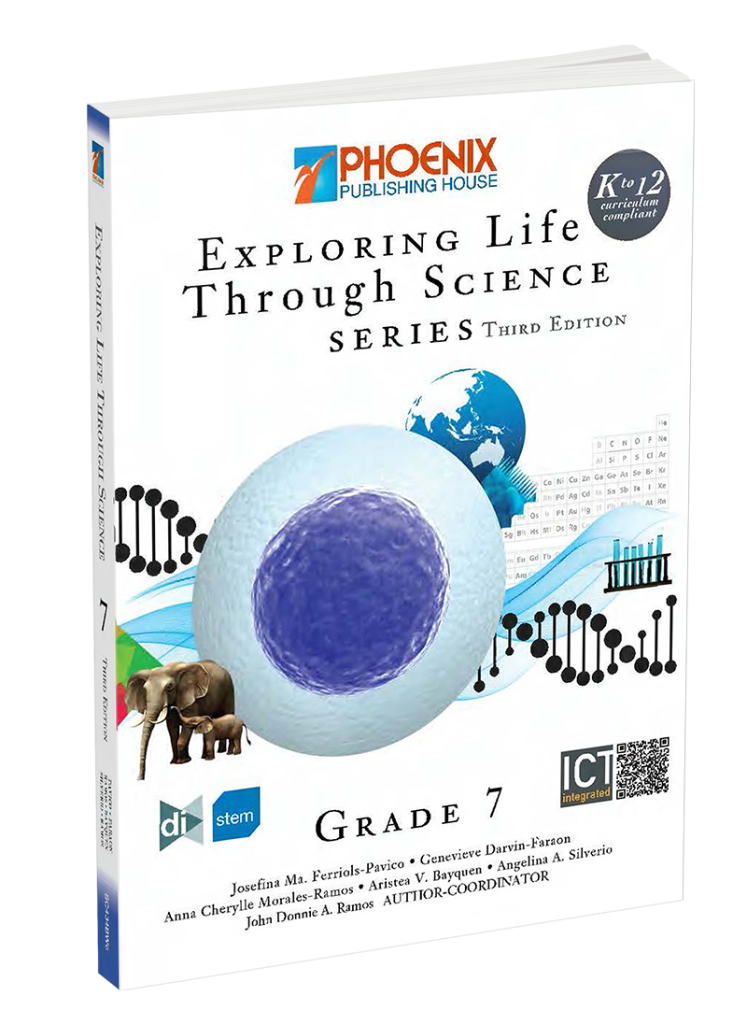Exploring Life Through Science Junior High School 7-10
Guided by the Department of Education’s updated K to 12 Curriculum Framework for Science, the third K to 12 edition of ELTS offers an integrated course on physics, earth science, chemistry, and biology. It emphasizes on interdisciplinary world-class science, practical technology, environment-centered science instruction, health issues, and the inculcation of Filipino pride. This book brings into the classrooms of young Filipinos the latest and relevant innovations in the sciences.
EDITION: Third Edition
Highlights:
Environmental responsibility
Interdisciplinary and world-class science
Filipino pride and culture
Innovative and practical science and technology
Ethical digital citizenship
Author/s
John Donnie A. Ramos (Author-Coordinator), Josefina Ma. Ferriols-Pavico, Genevieve Darvin-Faraon, Anna Cherylle Morales-Ramos, Aristea V. Bayquen, Angelina A. Silverio
Level/s
High School
Features:
Learning Objectives – highlights the learning competencies (both knowledge and skills), including the DepEd requirements
Big Idea and Theme Focus – core or central ideas of the chapter and presents the unifying theme of the different concepts in the chapter
A Closer Look – introduces real-life scenarios and asks teaser questions to jumpstart chapter discussions
Values – summarizes expected values to be developed in students
Concepts in a Box – shows a graphical representation of topics visualized in a concept map
Prior Knowledge Check – assesses initial knowledge and misconception of students
Love of Lab – school-based and take home tasks that challenges students to develop investigative and research skills
Proudly Filipino – highlights outstanding Filipino scientists to inspire students
My Future in Science – features professions in the sciences to encourage students to pursue similar or related careers
Sci Bit – supplements learning through information of human interest
Practical Science – gives examples of applications of science concepts in everyday life
Pillar of Science – features pioneer scientists in the different fields of science
Science Patrol – highlights breaking news in the sciences
Science Connections – focuses on a multidisciplinary scientific approach to solve human problems
Chapter Recap – recapitulates major concepts learned
A Closer Look Explained – explains the science behind a teaser question in the “A Closer Look”
Test Yourself – assesses the progress of students by testing their analytical and comprehension skills
Function Icons:
Information and Communications Technology (ICT) – emphasizes ICT-related contents and activities
Multiple Intelligences – identifies the different learning styles involved in the activities and assessments
Differentiated Instruction – emphasizes activities that address a wide range of learning needs, abilities, and interests of students
STEM – hands-on problem-based inquiry and exploration activities that challenge students to find solutions to real-world issues and problems as they are guided by the design thinking process
Quick Response (QR) Code – provides suggested resources as additional learning materials
21st Century Skills – activities that promote the development of twenty-first century skills such as learning, literacy, and life skills
Learning Skills (LE): (1) critical thinking, (2) creativity, (3) collaboration, (4) communication
Literacy Skills (LE): (1) information, (2) media, (3) technology
Life Skills (LE): (1) flexibility, (2) leadership, (3) initiative, (4) productivity, (5) social skills
Higher-Order Thinking Skills – develops higher-order thinking skills through learning activities and assessments
Values Integration (VI) – Transforms students into responsible members of the family and society
Components:
Textbook (TB)
Laboratory Manual (LM)
Teachers Wraparound Edition (TWE)
Teachers Wraparound Edition for Blended Learning (TWE-BL)
Teachers Resource CD



